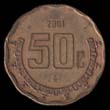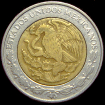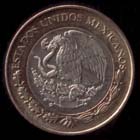Catalog of Mexican coins
Mexican coins
The Mexican peso (ISO 4217 code = MXN, symbol = $) is the national currency of Mexico. It comes from the “Peso de a Ocho” (piece of eight) issued in Mexico by Spain, also called Spanish dollars. Even after the declaration of independence of the September 28, 1821, Mexico continued to use the Spanish monetary system, with the gold escudo of 16 silver reales, the peso of 8 reales. The Mexican peso was also widely used outside the country, especially in the US, where the first dollars were issued on April 2, 1792 and the Mexican peso was officially recognized as legal tender until February 21, 1857.
Mexican Peso
The first coins minted in 1863 were Mexican peso cents (symbol = ¢), and in 1866 were minted the first Mexico peso coins with the image of the Emperor Maximilian on the obverse and the imperial emblem on the reverse.
Even after the declaration of the republic in 1967, Mexico continued to mint coins of 8 reales, along with Mexican peso and centavos coins; real coins were withdrawn from circulation in 1897. The 1 centavo coins were in copper. Between 1867 and 1869, 5, 10, 25 and 50 centavos silver coins were introduced with a title of .903 / 1000. In 1870 were introduced gold coins of 1, 2 1/2, 5, 10 and 20 pesos. In 1882, 1, 2 and 5 centavos coins were struck in cupro-nickel.
In 1905 Mexico introduced a monetary reform to the adopt the gold standard. The percentage of gold coins was reduced by 49.36%. Between 1910 and 1914 the famous "Caballito" was coined, a silver peso coin with the Mexican eagle emblem on the obverse and a woman riding on the reverse.
The title of the Mexican silver coins was reduced gradually becoming 800/100 in 1918, in 1920, 720/1000, 500/1000 in 1947, 300/1000 in 1950
In 1921 the circulation of gold coins ended, while in 1957 the last silver peso coin was minted.
A new series was minted between 1960 and 1971, with 1 and 5 centavos brass coins, 10, 25 and 50 centavos and 1, 5 and 10 pesos in cupro-nickel.
New peso
Due to the oil trade, the Mexican peso was extremely stabile. Following the oil crisis of the '70s, however, in 1982 Mexico was forced to declare insolvency of the foreign debt.
After years of high inflation, on January 1, 1993 the " Pacto de estabilidad y crecimiento económico " (Stability and Economic Growth Pact) was defined, with the adoption of the new peso (ISO 4217 MXN =, old code MXP, symbol = N$), with a ratio of 1.00 new peso to 1000 old ones; the term "new" was eliminated from the coins since 1 January 1996.
The new Mexican coins had values of 5 and 10 cents in steel, 20 and 50 centavos in bronze, in addition to bimetallic coins from 1, 2, 5 pesos in bronze in the middle and steel in the outer ring, while the 10, 20 and 50 pesos coins had a ring in bronze and silver in the middle, to the title of 925/1000. In 1996 the old silver 10 pesos coins from was replaced by common metal.















